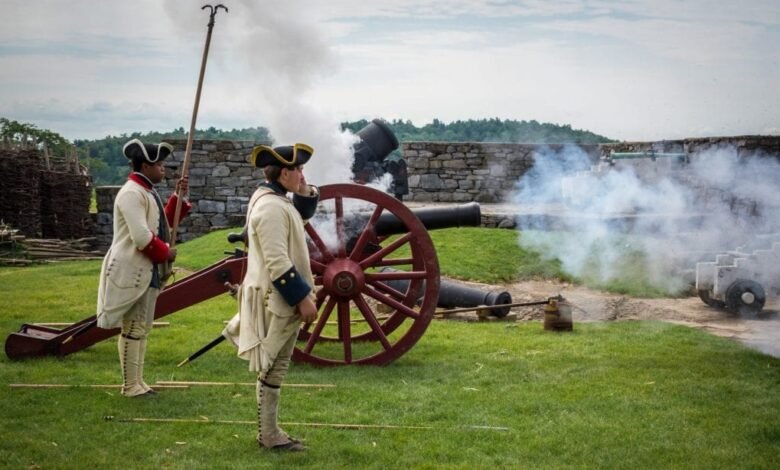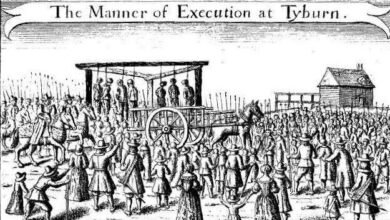French & Indian War Cannonballs Found In Lake George Over The Years


 On August 11, 1926, workers with Duplex Construction Company were prepping the ground for a new school being built on Canada Street in the Village of Lake George. At two feet below the surface, they uncovered a sizeable fragment of an iron cannonball.
On August 11, 1926, workers with Duplex Construction Company were prepping the ground for a new school being built on Canada Street in the Village of Lake George. At two feet below the surface, they uncovered a sizeable fragment of an iron cannonball.
The 18th century ordnance was unearthed from a famous French & Indian War (1755–1763) battle site, the August 1757 French siege of British-occupied Fort William Henry.
According to an article in the August 14, 1926 issue of the Lake George Mirror, the cannonball was described as being “broken.” The cannonball may have cracked after being fired. Or the ordnance might have been a section of bar shot, a dumbbell-shaped artillery projectile.
It also could have been a piece of chain shot, two iron shots attached by chain. In the colonial era, bar shot and chain shot were emp loyed to shred a warship’s sails. The news story did not indicate if the ammunition had a British broad arrow or French fleur-de-lis imprint.
The reporter of the 1926 news story noted, “It is probable that many more relics will be unearthed before work here is completed.” If any other military artifacts were revealed during the building venture, that news was apparently not published. Furthermore, it is not known what happened to the relic.
S
 hortly after workers excavated the cannonball remnant, the Duplex Construction Company ran ads in the Lake George Mirror looking to hire bricklayers to erect the school building.
hortly after workers excavated the cannonball remnant, the Duplex Construction Company ran ads in the Lake George Mirror looking to hire bricklayers to erect the school building.
In 1926, the Company had field offices in Glens Falls, Lake George, and Greenwich. For years, the business specialized in constructing schools, hospitals, and government buildings.
The 1926 discovery of the colonial cannonball from the landscape adjacent to Canada Street was not unusual.
Years earlier, in 1895, laborers dug up two cannonballs at the Lake House, the location of today’s Shepard Park on Canada Street.
In 1940, a couple of cannonballs were found during a work project near the head of the waterway.
In 1983, a French cannonball was exposed while excavating near the Old Warren County Courthouse on Canada Street. That antiquity ended up being exhibited in the Lake George Historical Association museum.
Decades ago, a blue-and-yellow historic marker entitled “Montcalm’s Camp 1757” was installed on the lawn of the Lake George secondary school. Montcalm refers to Louis-Joseph de Montcalm, who led the forces of New France.
The sign reads: “On these grounds Montcalm’s army camped during the siege of Fort Wm. Henry August 6–9, 1757.” Actually, the French attack, characterized by fierce artillery bombardment, lasted from August 3–9, 1757. The British garrison capitulated on August 9, and the following day the fort’s inhabitants departed for Fort Edward.

 The “Montcalm’s Camp 1757” historic marker is a reminder that the properties along Canada Street near the school, the Old Courthouse Building, Shepard Park, and replica Fort William Henry were once a theater of war.
The “Montcalm’s Camp 1757” historic marker is a reminder that the properties along Canada Street near the school, the Old Courthouse Building, Shepard Park, and replica Fort William Henry were once a theater of war.
Read more about the French & Indian War in New York State.
A version of this article first appeared on the Lake George Mirror, America’s oldest resort paper, covering Lake George and its surrounding environs. You can subscribe to the Mirror HERE.
Illustrations: French artillerymen fire a cannon at Fort Ticonderoga during a 2017 reenactment of the 1758 Battle of Carillon (courtesy Michael Kleen); Cannonballs exhibited at replica Fort William Henry, 2014 (courtesy Joseph Zarzynski); Montcalm’s Camp 1757 historical sign on Canada street in Lake George about the Siege of Fort William Henry (Zarzynski); and “Montcalm’s Camp 1757” (Zarzynski).
Source link




